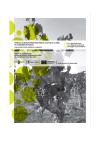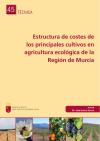Media library
Documentary, graphic and/or audiovisual knowledge objects are offered here, offering information on various sectors and topics. Use the keyword search or search filters to access current audiovisual and documentary knowledge objects useful for your implementation.
If you have any questions or suggestions, please contact us here.

Phytosanitary strategies in tomato
Strategies for the use of phytosanitary products in tomte cultivation

Cost structure of agricultural production areas in the Region of Murcia: stone fruit and citrus fruits
Publication dedicated to the cultivation of regional citrus and stone fruit trees

Cost structure of the agricultural production guidelines of the Region of Murcia: nuts, pome fruit, vines, and olives
Publication dedicated to the most characteristic woody crops of rural Murcia, including nuts, pome fruit, table and wine grapes, and olive trees.

Manual of good practices for vine cultivation in the region of Murcia. Socioeconomic and environmental assessment
The manual aims to convey, in a direct and simple way, to winegrowers and technicians involved in the regional wine chain, sustainable cultivation guidelines, both for dryland bush-fed vines and for irrigated trellis vines.

Cost structure of the main crops in organic farming in the Region of Murcia
Document describing the main guidelines for regional organic farming in Murcia

How to assess the quality of your soil. Visual soil assessment in olive groves
Guide that guides allows to estimate the visual evaluation of the soil (EVS) through a quick and simple method to estimate the condition of the soil, the suitability, quality and limitations that a soil presents for the olive grove
Active ingredients allowed in integrated production for pome fruit trees and restrictions on use
Information on active ingredients in integrated production for pome fruit trees and restrictions on use
Active ingredients allowed in integrated production for stone fruit trees and restrictions on use
Information on active ingredients in integrated production for stone fruit trees and restrictions on use
Rosaceae fire blight
Fire blight is a disease caused by the bacterium Erwinia amylovora that affects various species of the Rosaceae family, including pear, apple, quince, Japanese medlar, etc.
Drosophila suzukii treatment notice for cherry trees
In the various areas where Drosophila suzukii is being monitored, populations of this insect are being detected. Remember that attacks tend to be more intense and frequent at the beginning of the harvest, and treatment will be especially necessary in plots that were attacked in previous years and that left cherries unharvested last year (fly damage or cracking, lack of profitability, etc.).
Notice of treatment of plum moth (Cydia funebrana) in plum trees
The second generation of the plum moth has been seen flying between late May and early June in the Ribera and Val d'Albaida regions, and somewhat later in inland areas. Eggs will hatch this week and next. Treat accordingly.
Scirtothrips aurantii, information note and management recommendations, damage caused by thrips in citrus, persimmon and pomegranate.
Given the damage caused by thrips observed since May on leaves and fruit in various citrus, persimmon and pomegranate crops and the confirmation of the presence of Scirtothrips aurantii Faure in certain areas, the following recommendations have been considered appropriate:
Plant health, pest reports: Erwinia amylovora (fire blight)
Fire blight is a disease caused by the bacterium Erwinia amylovora that affects various species of the Rosaceae family, including pear, apple, quince, and Japanese medlar trees. It was detected in Cantabria in 2011 and is considered an extremely harmful disease.
Monitoring Scirtothrips aurantii on citrus, pomegranate and persimmon.
Scirtothrips aurantii is a pest that affects various crops such as pomegranates, persimmons, citrus fruits, and table grapes. This pest was first detected in Spain in 2020, in the province of Huelva.
Thaumatotibia leucotreta (Meyrik) Contingency Plan
This document sets out the measures to be adopted against Thaumatotibia leucotreta (codling moth), a pest regulated by the EU as a priority quarantine pest under Implementing Regulation (EU) 2019/2072 and Delegated Regulation (EU) 2019/170.
Aromia bungii (Faldermann) Contingency Plan
This document sets out the measures to be taken against Aromia bungii (Faldermann's beetle), a priority pest of the European Union (EU) according to Regulation (EU) 2016/2031 and Delegated Regulation (EU) 2019/1702, with the aim of preventing its appearance, and if it does appear, acting quickly and effectively, determining its distribution and combating it in order to prevent its spread a
Conotrachelus nenuphar (Herbts) Contingency Plan
This document sets out the measures to be taken against the cucurlionid Conotrachelus nenuphar (Herbts), a priority pest (according to Delegated Regulation (EU) 2019/1702) regulated in the European Union (EU) by Regulation (EU) 2016/2031 and Delegated Regulation (EU) 2019/1702, with the aim of preventing its appearance, and in case it appears, acting quickly and effectively, determining its dis
Contingency Plan for Anoplophora chinensis (Forster) and Anoplophora glabripennis (Motschulsky)
This document sets out the measures to be taken against two species of the genus Anoplophora, organisms regulated in the EU, with the aim of preventing their emergence and, if they do appear, acting quickly and effectively, determining their distribution and combating them with the aim of eradicating them.
Recommended chemical control strategy for pomegranate plots with Scirtothrips problems
Risk period from red tip to fruit measuring 3-5 cm Ø: The presence of Scirtothrips will be assessed weekly using the following methods: 1. Capture in yellow chromatic traps as an indication of early presence. These traps require inspection by specialized technical personnel. 2.




